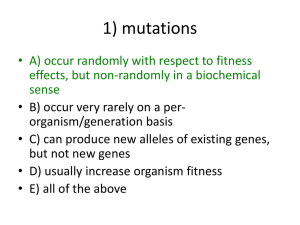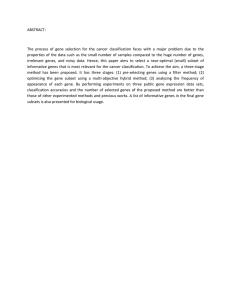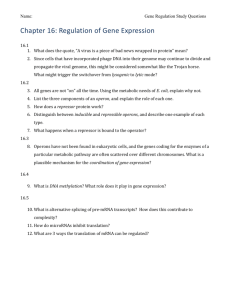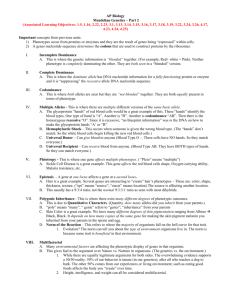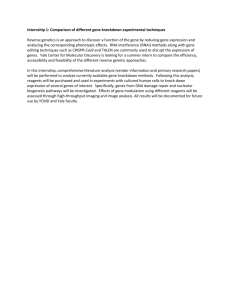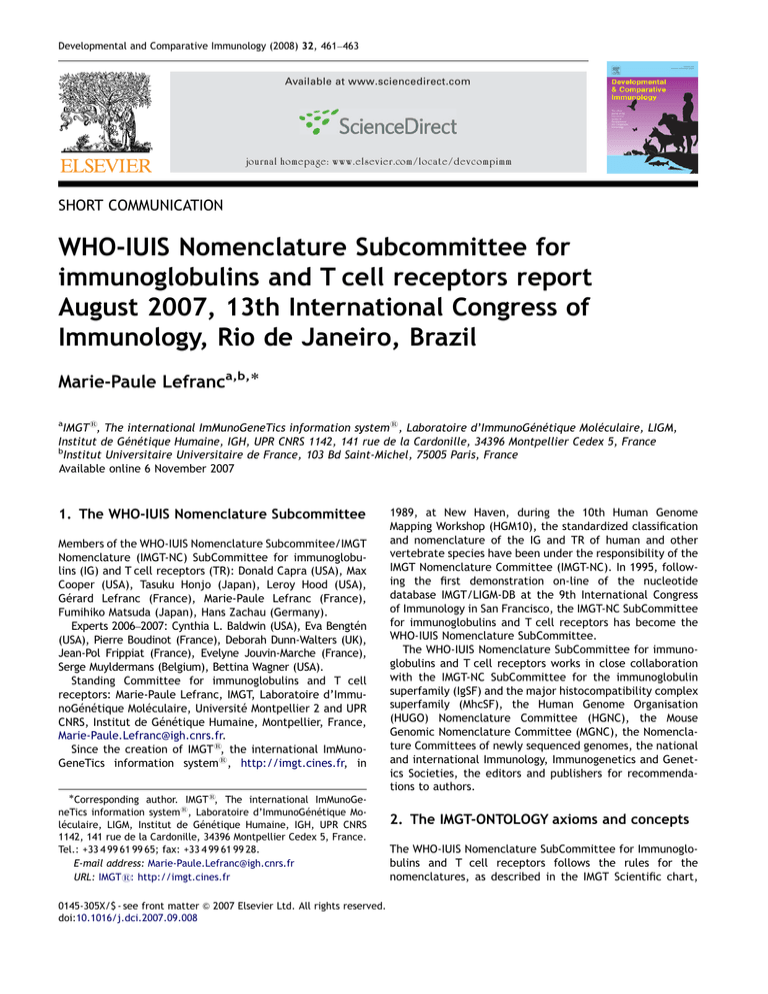
ARTICLE IN PRESS
Developmental and Comparative Immunology (2008) 32, 461–463
Available at www.sciencedirect.com
journal homepage: www.elsevier.com/locate/devcompimm
SHORT COMMUNICATION
WHO-IUIS Nomenclature Subcommittee for
immunoglobulins and T cell receptors report
August 2007, 13th International Congress of
Immunology, Rio de Janeiro, Brazil
Marie-Paule Lefranca,b,
a
IMGTs, The international ImMunoGeneTics information systems, Laboratoire d’ImmunoGénétique Moléculaire, LIGM,
Institut de Génétique Humaine, IGH, UPR CNRS 1142, 141 rue de la Cardonille, 34396 Montpellier Cedex 5, France
b
Institut Universitaire Universitaire de France, 103 Bd Saint-Michel, 75005 Paris, France
Available online 6 November 2007
1. The WHO-IUIS Nomenclature Subcommittee
Members of the WHO-IUIS Nomenclature Subcommitee/IMGT
Nomenclature (IMGT-NC) SubCommittee for immunoglobulins (IG) and T cell receptors (TR): Donald Capra (USA), Max
Cooper (USA), Tasuku Honjo (Japan), Leroy Hood (USA),
Gérard Lefranc (France), Marie-Paule Lefranc (France),
Fumihiko Matsuda (Japan), Hans Zachau (Germany).
Experts 2006–2007: Cynthia L. Baldwin (USA), Eva Bengtén
(USA), Pierre Boudinot (France), Deborah Dunn-Walters (UK),
Jean-Pol Frippiat (France), Evelyne Jouvin-Marche (France),
Serge Muyldermans (Belgium), Bettina Wagner (USA).
Standing Committee for immunoglobulins and T cell
receptors: Marie-Paule Lefranc, IMGT, Laboratoire d’ImmunoGénétique Moléculaire, Université Montpellier 2 and UPR
CNRS, Institut de Génétique Humaine, Montpellier, France,
Marie-Paule.Lefranc@igh.cnrs.fr.
Since the creation of IMGTs, the international ImMunoGeneTics information systems, http://imgt.cines.fr, in
Corresponding author. IMGTs, The international ImMunoGeneTics information systems, Laboratoire d’ImmunoGénétique Moléculaire, LIGM, Institut de Génétique Humaine, IGH, UPR CNRS
1142, 141 rue de la Cardonille, 34396 Montpellier Cedex 5, France.
Tel.: +33 4 99 61 99 65; fax: +33 4 99 61 99 28.
E-mail address: Marie-Paule.Lefranc@igh.cnrs.fr
URL: IMGTs: http://imgt.cines.fr
0145-305X/$ - see front matter & 2007 Elsevier Ltd. All rights reserved.
doi:10.1016/j.dci.2007.09.008
1989, at New Haven, during the 10th Human Genome
Mapping Workshop (HGM10), the standardized classification
and nomenclature of the IG and TR of human and other
vertebrate species have been under the responsibility of the
IMGT Nomenclature Committee (IMGT-NC). In 1995, following the first demonstration on-line of the nucleotide
database IMGT/LIGM-DB at the 9th International Congress
of Immunology in San Francisco, the IMGT-NC SubCommittee
for immunoglobulins and T cell receptors has become the
WHO-IUIS Nomenclature SubCommittee.
The WHO-IUIS Nomenclature SubCommittee for immunoglobulins and T cell receptors works in close collaboration
with the IMGT-NC SubCommittee for the immunoglobulin
superfamily (IgSF) and the major histocompatibility complex
superfamily (MhcSF), the Human Genome Organisation
(HUGO) Nomenclature Committee (HGNC), the Mouse
Genomic Nomenclature Committee (MGNC), the Nomenclature Committees of newly sequenced genomes, the national
and international Immunology, Immunogenetics and Genetics Societies, the editors and publishers for recommendations to authors.
2. The IMGT-ONTOLOGY axioms and concepts
The WHO-IUIS Nomenclature SubCommittee for Immunoglobulins and T cell receptors follows the rules for the
nomenclatures, as described in the IMGT Scientific chart,
ARTICLE IN PRESS
462
M.-P. Lefranc
http://imgt.cines.fr [1]. These rules are based on the
concepts of IMGT-ONTOLOGY [2,3], the first ontology in
immunogenetics and immunoinformatics. IMGT-ONTOLOGY
manages the immunogenetics knowledge through diverse
facets relying on seven axioms, ‘‘IDENTIFICATION’’,
‘‘DESCRIPTION’’, ‘‘CLASSIFICATION’’, ‘‘NUMEROTATION’’,
‘‘LOCALIZATION’’, ‘‘ORIENTATION’’ and ‘‘OBTENTION’’, that
postulate that objects, processes and relations have to be
identified, described, classified, numerotated, localized,
orientated, and that the way they are obtained has
to be determined. These axioms constitute the Formal
IMGT-ONTOLOGY, also designated as IMGT-Kaleidoscope
(Figure 1).
The CLASSIFICATION axiom has generated the concepts of
classification, which have been necessary to propose a
standardized nomenclature for the IG and TR genes. These
concepts take into account the highly polymorphic multigenic loci and families to which the IG and TR belong, their
rearrangements and their allelic polymorphisms. These
concepts are used whatever the antigen receptor (IG or
TR), whatever the locus (for mammals, for example, IG
heavy (IGH), IG kappa (IGK), IG lambda (IGL), TR alpha
(TRA), TR beta (TRB), TR gamma (TRG) and TR delta (TRD)),
whatever the gene configuration (germline, undefined
or rearranged), and whatever the species, from fish to
Figure 1
human. Among the concepts of classification, the ‘‘Group’’,
‘‘Subgroup’’, ‘‘Gene’’ and ‘‘Allele’’ concepts are essential.
2.1. The ‘‘Group’’ and ‘‘Subgroup’’ concepts
The ‘‘Group’’ concept classifies a set of genes that belong to
the same multigene family, within the same species or
between different species. For the IG and TR, the set of
genes is identified by an instance of the ‘‘GeneType’’
concept (V, D, J or C). The ‘‘Subgroup’’ concept classifies
a subset of genes that belong to the same group, and which,
in a given species, share at least 75% of identity at the
nucleotide sequence level (and in the germline configuration
for the V, D and J genes) (Figure 2).
2.2. The ‘‘Gene’’ and ‘‘Allele’’ concepts
The ‘‘Gene’’ concept classifies a unit of DNA sequence
that can be potentially transcribed and/or translated
(this definition includes the regulatory elements in 50 and
30 , and the introns, if present). The instances of the ‘‘Gene’’
concept are gene names. In IMGT-ONTOLOGY, a gene name is
composed of the name of the species (instance of the Taxon
‘‘Species’’ concept) and of the international HGNC/IMGT
Axioms of the formal IMGT-ONTOLOGY or IMGT-Kaleidoscope.
Figure 2 Concepts of classification for gene and allele nomenclature (CLASSIFICATION axiom). (A) Hierarchy of the concepts of
classification and their relations. (B) Examples of concept instances for each concept of classification. The concept instances are
associated with an instance of the ‘‘Taxon’’ concept, and more precisely for the ‘‘Gene’’ and ‘‘Allele’’ concepts with an instance of
the ‘‘Species’’ concept (here, Homo sapiens). The ‘‘Locus’’ concept is a concept of localization (LOCALIZATION axiom).
ARTICLE IN PRESS
WHO-IUIS Nomenclature Subcommittee for immunoglobulins and T cell receptors report
gene symbol, for example, Homo sapiens IGHV1-2 (human IG
heavy variable 1–2) (Figure 2). By extension, orphons and
pseudogenes are also instances of the ‘‘Gene’’ concept. The
‘‘Allele’’ concept classifies a polymorphic variant of a gene.
The instances of the ‘‘Allele’’ concept are allele names.
Alleles identified by the mutations of the nucleotide
sequence are classified by reference to allele *01. Full
description of mutations and allele name designations are
currently recorded for the core sequences (V-REGION,
D-REGION, J-REGION, C-REGION).
3. Immunoglobulin and T cell receptor genes
and alleles
3.1. Brief history
The IMGTs gene nomenclature has been approved at the
international level by the Human Genome Organisation
(HUGO) Nomenclature Committee (HGNC), in 1999. The
IMGTs genes were entered in the Genome Database (GDB)
and in LocusLink at the National Center for Biotechnology
Information (NCBI) in 1999–2000, and in Entrez Gene (NCBI)
[4], when this gene database superseded LocusLink. Two
FactsBooks on the human IG and TR genes and alleles were
published in 2001 [5,6]. The IMGT-NC received the official
delegation from HGNC for the IG and TR gene and allele
nomenclature in 2002 [7]. In order to manage the IG and TR
genes and alleles, IMGT/GENE-DB, the first IMGT genome
database, was created in January 2003 [8]. The IMGTs IG
and TR gene names are the official references for the
genome projects and, as such, have been integrated in the
MapViewer at NCBI and, in 2006, in the Ensembl server at
the European Bioinformatics Institute (EBI).
3.2. Present situation
The IG and TR genes and alleles are managed in the IMGT/
GENE-DB, which allows a search per gene name, based on
the CLASSIFICATION concept of IMGT-ONTOLOGY, and which
includes links to IMGT/LIGM-DB, IMGT Repertoire and
external databases. Links on individual entries between
IMGT, GDB, Entrez Gene and GeneCards have been established. In August 2007, IMGT/GENE-DB contains 1645 genes
(673 from human and 972 from mouse) and 2598 alleles
(1217 from human and 1381 from mouse). It comprises genes
and alleles for the seven loci (IGH, IGK, IGL, TRA, TRB, TRG
and TRD). The IG and/or TR genes from 50 other species are
currently available in the IMGT Repertoire in ‘‘Gene tables’’
and in ‘‘Alignment of alleles’’. For genes not yet localized in
the loci or for incomplete loci, a provisional nomenclature
has been assigned. With the completion of the genomes and
the sequence annotation, these genes will be progressively
entered in IMGT/GENE-DB.
4. Conclusion and perspectives
The standardization of the IG and TR genes and alleles by
the IMGT-NC and the WHO-IUIS Nomenclature SubCommittee
463
for immunoglobulins and T cell receptors represents a major
breakthrough in immunogenetics. This has been translated
in the IMGTs databases, tools and Web resources through
the huge work performed by the IMGTs team and its
constant motivation and expertise [9]. These combined
efforts contributed to make IMGTs, the international
ImMunoGeneTics information systems, http://imgt.
cines.fr, the global reference in immunogenetics and
immunoinformatics. The IMGTs Web server at Montpellier
receives more than 150,000 requests per month, from
Europe, the USA and the rest of the world. IMGTs is widely
used by clinicians and biological scientists from both
academic and industrial laboratories, in diverse research
domains: (i) fundamental and medical research (repertoire
analysis of the IG antibody sites and of the TR recognition
sites in normal and pathological situations, such as
autoimmune diseases, infectious diseases, AIDS, leukemias,
lymphomas, myelomas), (ii) veterinary research (IG and TR
repertoires in farm and wildlife species), (iii) genome
diversity and genome evolution studies of the adaptive
responses, (iv) structural evolution of the IgSF and
MhcSF proteins, (v) biotechnology related to antibody
engineering (single chain Fragment variable (scFv),
phage displays, combinatorial libraries, chimeric, humanized and human antibodies), (vi) diagnostics (clonalities,
detection and follow-up of residual diseases) and
(vii) therapeutical approaches (grafts, immunotherapy,
vaccinology).
References
[1] Lefranc M-P, Giudicelli V, Kaas Q, Duprat E, Jabado-Michaloud J,
Scaviner D, et al. IMGT, the international ImMunoGeneTics
information systems. Nucl Acids Res 2005;33:D593–7.
[2] Giudicelli V, Lefranc M-P. Ontology for immunogenetics: IMGTONTOLOGY. Bioinformatics 1999;15:1047–54.
[3] Lefranc M.-P, Giudicelli V, Ginestoux C, Bosc N, Folch G,
Guiraudou D, et al. IMGT-ONTOLOGY for immunogenetics and
immunoinformatics, http://imgt.cines.fr. In Silico Biol
2004;4:17–29. Epub 2003, 0004, 22 Nov 2003.
[4] Maglott D, Ostell J, Pruitt KD, Tatusova T. Entrez Gene:
gene-centered information at NCBI. Nucl Acids Res 2007;35:
D26–31.
[5] Lefranc M-P, Lefranc G. The immunoglobulin factsbook. New
York: Academic Press; 2001. 458p.
[6] Lefranc M-P, Lefranc G. The T cell receptor factsbook. New York:
Academic Press; 2001. 398p.
[7] Wain HM, Bruford EA, Lovering RC, Lush MJ, Wright MW, Povey S.
Guidelines for human gene nomenclature. Genomics 2002;79:
464–70.
[8] Giudicelli V, Chaume D, Lefranc M-P. IMGT/GENE-DB:
a comprehensive database for human and mouse immunoglobulin and T cell receptor genes. Nucl Acids Res 2005;33:
D256–61.
[9] Duroux P, Giudicelli V, Kaas Q, Jabado-Michaloud J, Folch G,
Ginestoux C, et al. IMGTs, the international ImMunoGeneTics
information systems, the reference in immunogenetics and
immunoinformatics. In: Fattoum A, editor. Proceedings of the
first international congress on macromolecular biochemistry and
genetics. Tunisia: Gafsa; 12–16 April 2007, in press.


